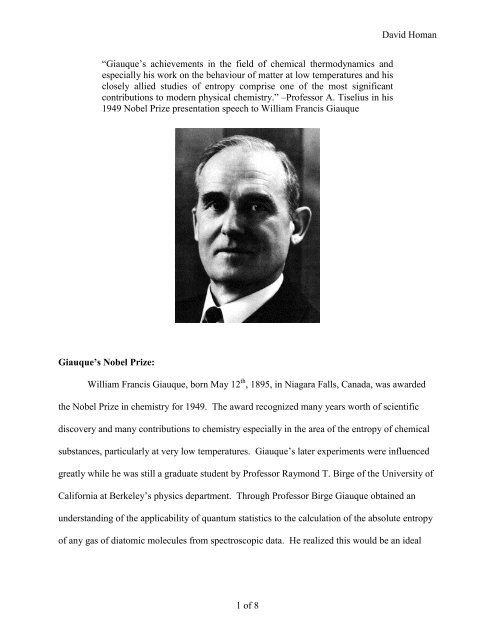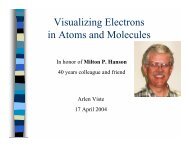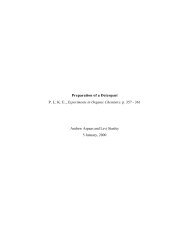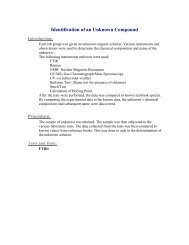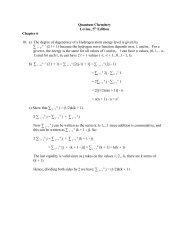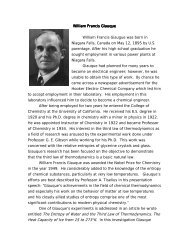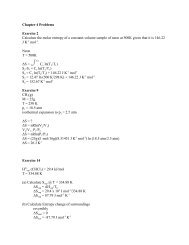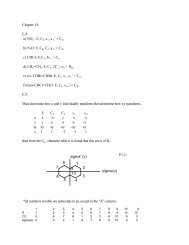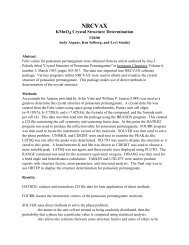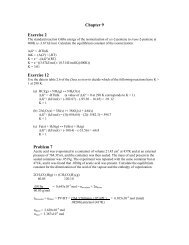David Homan 1 of 8 “Giauque's achievements in the field of ...
David Homan 1 of 8 “Giauque's achievements in the field of ...
David Homan 1 of 8 “Giauque's achievements in the field of ...
You also want an ePaper? Increase the reach of your titles
YUMPU automatically turns print PDFs into web optimized ePapers that Google loves.
<strong>David</strong> <strong>Homan</strong><br />
“Giauque’s <strong>achievements</strong> <strong>in</strong> <strong>the</strong> <strong>field</strong> <strong>of</strong> chemical <strong>the</strong>rmodynamics and<br />
especially his work on <strong>the</strong> behaviour <strong>of</strong> matter at low temperatures and his<br />
closely allied studies <strong>of</strong> entropy comprise one <strong>of</strong> <strong>the</strong> most significant<br />
contributions to modern physical chemistry.” –Pr<strong>of</strong>essor A. Tiselius <strong>in</strong> his<br />
1949 Nobel Prize presentation speech to William Francis Giauque<br />
Giauque’s Nobel Prize:<br />
William Francis Giauque, born May 12 th , 1895, <strong>in</strong> Niagara Falls, Canada, was awarded<br />
<strong>the</strong> Nobel Prize <strong>in</strong> chemistry for 1949. The award recognized many years worth <strong>of</strong> scientific<br />
discovery and many contributions to chemistry especially <strong>in</strong> <strong>the</strong> area <strong>of</strong> <strong>the</strong> entropy <strong>of</strong> chemical<br />
substances, particularly at very low temperatures. Giauque’s later experiments were <strong>in</strong>fluenced<br />
greatly while he was still a graduate student by Pr<strong>of</strong>essor Raymond T. Birge <strong>of</strong> <strong>the</strong> University <strong>of</strong><br />
California at Berkeley’s physics department. Through Pr<strong>of</strong>essor Birge Giauque obta<strong>in</strong>ed an<br />
understand<strong>in</strong>g <strong>of</strong> <strong>the</strong> applicability <strong>of</strong> quantum statistics to <strong>the</strong> calculation <strong>of</strong> <strong>the</strong> absolute entropy<br />
<strong>of</strong> any gas <strong>of</strong> diatomic molecules from spectroscopic data. He realized this would be an ideal<br />
1 <strong>of</strong> 8
<strong>David</strong> <strong>Homan</strong><br />
reference to compare experimental values <strong>of</strong> entropy. As a result, he set out to test <strong>the</strong> third law<br />
<strong>of</strong> <strong>the</strong>rmodynamics.<br />
Through amaz<strong>in</strong>g experimental skill he was able to design techniques for obta<strong>in</strong><strong>in</strong>g<br />
accurate measurements at temperatures near<strong>in</strong>g absolute zero. While prepar<strong>in</strong>g to present a<br />
sem<strong>in</strong>ar on <strong>the</strong> relationship between magnetism and <strong>the</strong>rmodynamics <strong>in</strong> 1924, Giauque<br />
postulated about adiabatic demagnetization. He freely discussed his thoughts about adiabatic<br />
demagnetization with colleagues <strong>in</strong> Berkeley where he was a pr<strong>of</strong>essor, but did not publish a<br />
paper on his idea until 1927. In March <strong>of</strong> 1933, while work<strong>in</strong>g with a student named D.P.<br />
MacDougall, Giauque f<strong>in</strong>ally carried out <strong>the</strong> first adiabatic demagnetization experiment yield<strong>in</strong>g<br />
0.25 K. Adiabatic demagnetization was a means to allow Giauque to pursue his primary <strong>in</strong>terest:<br />
entropy and <strong>the</strong> third law <strong>of</strong> <strong>the</strong>rmodynamics. He was a meticulous experimenter who took<br />
extremely accurate absolute measurements with his goal be<strong>in</strong>g an accuracy <strong>of</strong> 0.1%.<br />
Giauque’s <strong>field</strong> <strong>of</strong> study was not just limited to low temperature entropy measurements,<br />
but also to measur<strong>in</strong>g <strong>the</strong> heat capacities and heats <strong>of</strong> transition <strong>of</strong> <strong>the</strong> halogen acids from very<br />
low temperatures to <strong>the</strong>ir boil<strong>in</strong>g po<strong>in</strong>ts, study<strong>in</strong>g <strong>the</strong> spectra <strong>of</strong> diatomic molecules lead<strong>in</strong>g to<br />
<strong>the</strong> discovery <strong>of</strong> <strong>the</strong> isotopes <strong>of</strong> oxygen <strong>in</strong> 1929, and determ<strong>in</strong><strong>in</strong>g <strong>the</strong> difference <strong>in</strong> entropy<br />
between <strong>the</strong> glass form and <strong>the</strong> crystall<strong>in</strong>e form <strong>of</strong> glycer<strong>in</strong>e. Overall, throughout his career he<br />
published scientific work <strong>in</strong> 75 papers.<br />
The Entropy <strong>of</strong> Hydrogen chloride:<br />
The purpose for determ<strong>in</strong><strong>in</strong>g <strong>the</strong> calorimetric entropy <strong>of</strong> a halogen acid was <strong>the</strong> test<strong>in</strong>g <strong>of</strong><br />
<strong>the</strong> third law <strong>of</strong> <strong>the</strong>rmodynamics as well as to compare <strong>the</strong> data collected with <strong>the</strong> previous data<br />
obta<strong>in</strong>ed from various <strong>the</strong>ories with <strong>the</strong> aid <strong>of</strong> spectroscopic data. Hydrogen chloride was used<br />
2 <strong>of</strong> 8
<strong>David</strong> <strong>Homan</strong><br />
because <strong>of</strong> <strong>the</strong> reliability <strong>of</strong> its spectra measurements and <strong>the</strong> reliability <strong>of</strong> its spectra<br />
<strong>in</strong>terpretation. However, <strong>the</strong> preparation <strong>of</strong> pure anhydrous hydrogen chloride <strong>in</strong> quantities large<br />
enough for <strong>the</strong> experiment was one <strong>of</strong> <strong>the</strong> most difficult challenges solved for this particular<br />
determ<strong>in</strong>ation by Giauque. 3.5 moles were required to fill <strong>the</strong> calorimeter, but as much as 10<br />
moles was used to account for losses throughout <strong>the</strong> experiment.<br />
The hydrogen chloride was extensively processed to prepare it for measurement. Two<br />
problems Giauque ran <strong>in</strong>to dur<strong>in</strong>g <strong>the</strong> purification process were: <strong>the</strong> condensed hydrogen<br />
chloride “was <strong>of</strong> a reddish p<strong>in</strong>k color” and solid white particles appeared <strong>in</strong> <strong>the</strong> colorless liquid<br />
upon melt<strong>in</strong>g <strong>the</strong>refore h<strong>in</strong>t<strong>in</strong>g at impurities. Giauque later hypo<strong>the</strong>sized that <strong>the</strong> reddish p<strong>in</strong>k<br />
material was an unstable crystall<strong>in</strong>e form <strong>of</strong> hydrogen chloride only present when <strong>the</strong> hydrogen<br />
chloride was at <strong>the</strong> temperature <strong>of</strong> liquid air. The white particles were hypo<strong>the</strong>sized to be<br />
phosphorus oxychloride which can be prepared by <strong>the</strong> <strong>in</strong>teraction <strong>of</strong> hot hydrogen chloride with<br />
phosphorus pentoxide.<br />
Once Giauque and Wiebe had obta<strong>in</strong>ed purified anhydrous hydrogen chloride he<br />
determ<strong>in</strong>ed <strong>the</strong> vapor pressures <strong>of</strong> <strong>the</strong> solid form. The results are given <strong>in</strong> <strong>the</strong> table below<br />
(Figure 1). They calculated <strong>the</strong> pressures given <strong>in</strong> <strong>the</strong> fourth column us<strong>in</strong>g <strong>the</strong> equation: log P<br />
(cm Hg) = -1114/T – 1.285logT – 0.0009467T + 11.00500. The constants were chosen to fit <strong>the</strong><br />
observed data.<br />
3 <strong>of</strong> 8
<strong>David</strong> <strong>Homan</strong><br />
T, K P obs. (cm Hg) P calc. T obs. - T calc.<br />
132.48 0.558 0.554 -0.05<br />
132.82 0.589 0.580 -0.12<br />
135.2 0.787 0.797 0.10<br />
139.23 1.308 1.310 0.01<br />
143.00 2.044 2.041 -0.01<br />
145.77 2.782 2.783 0.00<br />
148.44 3.705 3.709 0.01<br />
154.29 6.692 6.710 0.03<br />
155.04 7.221 7.215 -0.01<br />
158.91 10.370 10.371 0.00<br />
10.371<br />
Figure 1. Vapor Pressures <strong>of</strong> Solid Hydrogen Chloride (Giauque and Wiebe, 105)<br />
He also determ<strong>in</strong>ed <strong>the</strong> vapor pressures <strong>of</strong> liquid hydrogen chloride and <strong>the</strong>se results are<br />
given <strong>in</strong> Figure 2. The calculated pressures given <strong>in</strong> <strong>the</strong> fourth column were obta<strong>in</strong>ed from <strong>the</strong><br />
equation developed by Henn<strong>in</strong>g and Stock 1 : log P (mm Hg) = -905.53/T + 175logT – 0.005077T<br />
+ 4.65739.<br />
T, K P obs. (cm Hg) P calc. T obs. - T calc.<br />
158.91 10.371 10.357 -0.02<br />
164.62 16.29 16.260 -0.03<br />
169.28 22.98 22.930 -0.03<br />
173.95 31.71 31.720 0.00<br />
178.53 42.81 42.830 0.01<br />
181.84 52.64 52.650 0.00<br />
185.17 64.34 64.290 -0.01<br />
188.41 77.48 77.470 0.00<br />
191.96 94.39 94.280 -0.02<br />
195.93 116.510 116.330 -0.03<br />
Figure 2. Vapor Pressures <strong>of</strong> Liquid Hydrogen Chloride (Giauque and Wiebe, 106)<br />
For <strong>the</strong> vapor pressure measurements a copper shea<strong>the</strong>d glass apparatus was used, but it<br />
was not employed for <strong>the</strong> calorimetric measurements because <strong>of</strong> experience <strong>of</strong> o<strong>the</strong>rs at<br />
Giauque’s laboratory that glass calorimeters were <strong>in</strong>ferior ma<strong>in</strong>ly because <strong>the</strong> accuracy is<br />
decreased by <strong>the</strong> poor <strong>the</strong>rmal conductivity. So, for <strong>the</strong> calorimetric measurements, Giauque and<br />
Wiebe designed a sophisticated apparatus made from gold sheet 0.75 mm <strong>in</strong> thickness with<br />
welded seams. In order to correct a known source <strong>of</strong> error energy was <strong>in</strong>troduced <strong>in</strong>to <strong>the</strong><br />
4 <strong>of</strong> 8
<strong>David</strong> <strong>Homan</strong><br />
system. The source <strong>of</strong> this energy was a comb<strong>in</strong>ed <strong>the</strong>rmometer-heater that also allowed <strong>the</strong><br />
measurement <strong>of</strong> temperature <strong>in</strong>tervals. This resistance <strong>the</strong>rmometer, after calibration, was found<br />
to be so precise that its accuracy was with<strong>in</strong> 0.05 K.<br />
Next <strong>the</strong>y obta<strong>in</strong>ed <strong>the</strong> heat capacity <strong>of</strong> hydrogen chloride us<strong>in</strong>g his new calorimeter.<br />
Because <strong>the</strong>y knew energy was be<strong>in</strong>g <strong>in</strong>put <strong>in</strong>to <strong>the</strong> system <strong>the</strong>y were able to calculate <strong>the</strong> heat<br />
capacities with<strong>in</strong> <strong>the</strong> range <strong>of</strong> 17.29 K to 188.07 K. The data is presented <strong>in</strong> Figure 3. The<br />
density <strong>of</strong> solid hydrogen chloride was determ<strong>in</strong>ed by Simon and Simson 2 and <strong>the</strong> density <strong>of</strong><br />
liquid hydrogen chloride has been determ<strong>in</strong>ed by Baumg and Perrot 3 .<br />
T, K C p /mole (cal/deg) T, K C p /mole (cal/deg) T, K C p /mole (cal/deg)<br />
17.29 1.031 67.85 5.848 117.30 10.14<br />
21.34 1.637 72.63 6.159 123.92 10.46<br />
24.71 2.066 75.46 6.329 131.18 10.67<br />
26.85 2.330 77.65 6.526 138.79 10.95<br />
28.10 2.491 80.25 6.712 148.90 11.34<br />
31.89 2.943 82.63 6.894 155.06 11.65<br />
35.82 3.393 84.69 7.053 158.91 Melt<strong>in</strong>g po<strong>in</strong>t<br />
39.95 3.794 87.70 7.327 163.72 13.89<br />
44.20 4.132 88.79 7.410 171.45 13.95<br />
48.62 4.472 92.83 7.786 171.74 13.95<br />
51.23 4.677 92.96 7.849 178.64 14.01<br />
56.01 5.070 98.36 Transition 185.20 14.07<br />
58.94 5.231 103.01 9.64 188.07 Boil<strong>in</strong>g po<strong>in</strong>t<br />
63.31 5.550<br />
Figure 3. Heat Capacity <strong>of</strong> Hydrogen Chloride (Giauque and Wiebe, 110)<br />
For <strong>the</strong>ir calculation <strong>of</strong> <strong>the</strong> entropy <strong>of</strong> hydrogen chloride, Giauque and Wiebe determ<strong>in</strong>ed<br />
heats <strong>of</strong> transition, fusion, and vaporization. Heats <strong>of</strong> fusion and transition were measured by<br />
<strong>in</strong>putt<strong>in</strong>g heat at a temperature below <strong>the</strong> melt<strong>in</strong>g or transition temperature and end<strong>in</strong>g <strong>the</strong> <strong>in</strong>put<br />
just above. The heat <strong>of</strong> transition was determ<strong>in</strong>ed to be 98.36 K and <strong>the</strong> average ÈH was 284.3<br />
cal mol -1 . The heat <strong>of</strong> fusion was determ<strong>in</strong>ed to be 158.91 K and <strong>the</strong> average ÈH was 476.0 cal<br />
1 Henn<strong>in</strong>g and Stock, Z. Physik, 4, 226 (1921).<br />
2 Simon and Simson, Z. Physik, 21, 168 (1924).<br />
5 <strong>of</strong> 8
<strong>David</strong> <strong>Homan</strong><br />
mol -1 . To calculate <strong>the</strong> heat <strong>of</strong> vaporization at atmospheric pressure two methods were used, but<br />
both methods determ<strong>in</strong>ed <strong>the</strong> amount <strong>of</strong> material evaporated by absorption <strong>in</strong> a solution <strong>of</strong><br />
sodium hydroxide. The results for methods I and II were 3859 ± 9 cal mol -1 and 3860 ± 4 cal<br />
mol -1 respectively. Giauque and Wiebe felt more confidence <strong>in</strong> method II because <strong>the</strong> results<br />
from this method showed a smaller deviation from <strong>the</strong> mean than <strong>the</strong> results from method I.<br />
The entropy <strong>of</strong> hydrogen chloride was obta<strong>in</strong>ed by graphical <strong>in</strong>tegration <strong>of</strong> <strong>the</strong> equation S<br />
= fC p dlnT (from 0 to T) plus <strong>the</strong> entropy changes accompany<strong>in</strong>g each change <strong>of</strong> state. The<br />
Debye function (C p ≅ T 3 ) was employed below <strong>the</strong> lowest temperature <strong>of</strong> measurement.<br />
Giaque’s and Wiebe’s entropy calculations are summated <strong>in</strong> Figure 4.<br />
Solid stable below 98.36 K S (cal K -1 mol -1 )<br />
0 to 16 K, extrapolation 0.30<br />
16 K to 98.36 K, graphical 7.06<br />
Transition 284.3/98.35 = 2.89<br />
Solid stable above 98.36 K<br />
98.36 K to 158.91 K, graphical 5.05<br />
Fusion 476.0/158.91 = 3.00<br />
Liquid<br />
158.91 K to 188.07 K, graphical 2.36<br />
Vaporization, 3860/88.07 = 20.52<br />
Entropy <strong>of</strong> HCl (g) at boil<strong>in</strong>g pt. =<br />
41.2 +/- 0.1 E.U.<br />
Figure 4. Calculation <strong>of</strong> Entropy <strong>of</strong> Hydrogen Chloride (Giauque and Wiebe, 116)<br />
Giauque and Wiebe tested <strong>the</strong>ir results by calculat<strong>in</strong>g <strong>the</strong> entropy for hydrogen chloride<br />
us<strong>in</strong>g spectroscopic data. Us<strong>in</strong>g two different methods, <strong>the</strong>y concluded that <strong>the</strong> value for entropy<br />
us<strong>in</strong>g <strong>the</strong> spectroscopic data was very similar to <strong>the</strong>ir calorimetric value. They summarized this<br />
f<strong>in</strong>d<strong>in</strong>g by say<strong>in</strong>g, “The close agreement <strong>of</strong> our experimental and <strong>the</strong>oretical values is very good<br />
evidence, not only for <strong>the</strong> validity <strong>of</strong> <strong>the</strong> <strong>the</strong>oretical considerations as closely approximat<strong>in</strong>g <strong>the</strong><br />
actual properties <strong>of</strong> <strong>the</strong> substance, but also for <strong>the</strong> third law <strong>of</strong> <strong>the</strong>rmodynamics.” They fur<strong>the</strong>r<br />
3 Baumg and Perrot, J. chim. phys., 12, 225 (1914).<br />
6 <strong>of</strong> 8
<strong>David</strong> <strong>Homan</strong><br />
tested <strong>the</strong>ir results by calculat<strong>in</strong>g ÈS us<strong>in</strong>g Gibbs free energy values for chlor<strong>in</strong>e and hydrogen.<br />
The value obta<strong>in</strong>ed for hydrogen chloride us<strong>in</strong>g <strong>the</strong> Gibbs <strong>in</strong>formation was 44.5 cal K -1 mol -1<br />
which is very similar to <strong>the</strong>ir calorimetric value.<br />
7 <strong>of</strong> 8
<strong>David</strong> <strong>Homan</strong><br />
Works Cited<br />
“Biography <strong>of</strong> William Francis Giauque.” URL:<br />
http://www.nobel.se/chemistry/laureates/1949/giauque-bio.html.<br />
Giauque, W.F. and R. Wiebe. “The Entropy <strong>of</strong> Hydrogen Chloride. Heat Capacity from 16°K.<br />
to Boil<strong>in</strong>g Po<strong>in</strong>t. Heat <strong>of</strong> Vaporization. Vapor Pressures <strong>of</strong> Solid and Liquid.” Journal<br />
<strong>of</strong> <strong>the</strong> American Chemical Society 50:101-22.<br />
“Noble Prize <strong>in</strong> Chemistry 1949- Prize Presentation.” URL:<br />
http://www.nobel.se/chemistry/laureates/1949/press.html.<br />
Pitzer, Kenneth S. and <strong>David</strong> A. Shirley. “William Francis Giauque, May 12, 1895-March 28,<br />
1982.” URL: http://bob.nap.edu/html/biomems/wgiauque.html.<br />
8 <strong>of</strong> 8


